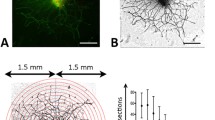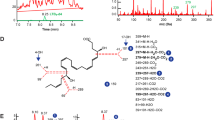Abstract
Purpose
Corneal sensation, cell proliferation, and wound healing all depend on adequate corneal innervation. Disruption of corneal innervation can lead to dry eye and delayed wound healing. Our studies in rats and rabbits show that the substituted fluorobenzamide drug FK962 accelerates the extension of neuronal processes and recovery of corneal sensitivity. The purpose of the present study was 1) to determine whether FK962 induces sprouting and elongation of neurites in cultured monkey trigeminal ganglion cells, and 2) to investigate the involvement of the neurotrophic peptide GDNF in FK962-induced neurite elongation.
Methods
Dissociated, cultured trigeminal ganglion cells, containing neuronal and Schwann cells were cultured for 48 h with or without FK962. Neuronal elongation was evaluated by immunostaining with a neurofilament-specific antibody. Culture with or without GDNF, or with antibody against GDNF, was used to determine the role of GDNF in FK962-induced neurite elongation.
Results
FK962 or GDNF were found to significantly induce neurite elongation. The GDNF antibody significantly inhibited elongation induced by FK962.
Conclusion
GDNF was found to be a mediator of FK962-induced neurite elongation in a relevant primate model. FK962 may be a candidate drug for treatment of neurotrophic disorders in the human cornea.



Similar content being viewed by others
References
Müller LJ, Vrensen GF, Pels L, Cardozo BN, Willekens B (1997) Architecture of human corneal nerves. Invest Ophthalmol Vis Sci 38:985–994
Nishida T (2005) Neurotrophic mediators and corneal wound healing. Ocul Surf 3:194–202
Goins KM (2005) New insights into the diagnosis and treatment of neurotrophic keratopathy. Ocul Surf 3:96–110
Sigelman S, Friedewald JS (1954) Mitotic and wound-healing activities of the corneal epithelium; effect of sensory denervation. AMA Arch Ophthalmol 52:46–57
Cruzat A, Pavan-Langston D, Hamrah P (2010) In vivo confocal microscopy of corneal nerves: analysis and clinical correlation. Semin Ophthalmol 25:171–177
Lee BH, McLaren JW, Erie JC, Hodge DO, Bourne WM (2002) Reinnervation in the cornea after LASIK. Invest Ophthalmol Vis Sci 43:3660–3664
Ueno H, Ferrari G, Hattori T, Saban DR, Katikireddy KR, Chauhan SK, Dana R (2012) Dependence of corneal stem/progenitor cells on ocular surface innervation. Invest Ophthalmol Vis Sci 53:867–872
Toda I (2007) LASIK and dry eye. Compr Ophthalmol Updat 8:79–85, discussion 87-89
Fukiage C, Nakajima T, Takayama Y, Minagawa Y, Shearer T, Azuma M (2007) PACAP induces neurite outgrowth in cultured trigeminal ganglion cells and recovery of corneal sensitivity after flap surgery in rabbits. Am J Ophthalmol 143:255–262
Nakajima E, Walkup RD, Fujii A, Shearer TR, Azuma M (2013) Pituitary adenylate cyclase-activating peptide induces neurite outgrowth in cultured monkey trigeminal ganglion cells: involvement of receptor PAC1. Mol Vis 19:174–183
Tokita K, Inoue T, Yamazaki S, Wang F, Yamaji T, Matsuoka N, Mutoh S (2005) FK962, a novel enhancer of somatostatin release, exerts cognitive-enhancing actions in rats. Eur J Pharmacol 527:111–120
Kishimoto Y, Yabuta C, Shearer TR, Azuma M (2012) FK962 promotes neurite elongation and regeneration of cultured rat trigeminal ganglion cells: possible involvement of GDNF. Invest Ophthalmol Vis Sci 53:5312–5319
Geenen K, Favoreel HW, Nauwynck HJ (2005) Higher resistance of porcine trigeminal ganglion neurons towards pseudorabies virus-induced cell death compared with other porcine cell types in vitro. J Gen Virol 86:1251–1260
Yabuta C, Oka T, Kishimoto Y, Ohtori A, Yoshimatsu A, Azuma M (2012) Topical FK962 facilitates axonal regeneration and recovery of corneal sensitivity after flap surgery in rabbits. Am J Ophthalmol 153:651–660
Taniwaki T, Schwartz JP (1995) Somatostatin enhances neurofilament expression and neurite outgrowth in cultured rat cerebellar granule cells. Brain Res Dev Brain Res 88:109–116
Airaksinen MS, Saarma M (2002) The GDNF family: signalling, biological functions and therapeutic value. Nat Rev Neurosci 3:383–394
Brock JH, Rosenzweig ES, Blesch A, Moseanko R, Havton LA, Edgerton VR, Tuszynski MH (2010) Local and remote growth factor effects after primate spinal cord injury. J Neurosci 30:9728–9737
Matsuoka N, Aigner TG (1997) Effect of FR121196, a novel cognitive enhancer, on the memory impairment of rats in passive avoidance and radial arm maze tasks. J Pharmacol Exp Ther 263:436–444
Calabrese EJ (2008) Dose-response features of neuroprotective agents: an integrative summary. Crit Rev Toxicol 38:253–348
Nicole O, Ali C, Docagne F, Plawinski L, MacKenzie E, Vivien D, Buisson A (2001) Neuroprotection mediated by glial cell line-derived neurotrophic factor: involvement of a reduction of NMDA-induced calcium influx by the mitogen-activated protein kinase pathway. J Neurosci 21:3024–3033
Allen SJ, Watson JJ, Shoemark DK, Barua NU, Patel NK (2013) GDNF, NGF and BDNF as therapeutic options for neurodegeneration. Pharmacol Ther 138:155–175
Sieving PA (2012) Vision research needs, gaps, and opportunities. National Eye Institute, pp 27 https://nei.nih.gov/sites/default/files/nei-pdfs/VisionResearch2012.pdf. Accessed 14 Apr 2016
Nielsen J, Gotfryd K, Li S, Kulahin N, Soroka V, Rasmussen KK, Bock E, Berezin V (2009) Role of glial cell line-derived neurotrophic factor (GDNF)-neural cell adhesion molecule (NCAM) interactions in induction of neurite outgrowth and identification of a binding site for NCAM in the heel region of GDNF. J Neurosci 29:11360–11376
Omoto M, Yoshida S, Miyashita H, Kawakita T, Yoshida K, Kishino A, Kimura T, Shibata S, Tsubota K, Okano H, Shimmura S (2012) The semaphorin 3A inhibitor SM-345431 accelerates peripheral nerve regeneration and sensitivity in a murine corneal transplantation model. PLoS ONE 7:e47716
Wanigasekara Y, Keast JR (2006) Nerve growth factor, glial cell line-derived neurotrophic factor and neurturin prevent semaphorin 3A-mediated growth cone collapse in adult sensory neurons. Neuroscience 142:369–379
Author information
Authors and Affiliations
Corresponding author
Ethics declarations
Funding
Senju Pharmaceutical Co., Ltd. provided support in the form of research funding. This research was also supported in part by NIH grant RR000163 to the Oregon National Primate Research Center.
Conflict of interest
Dr. Shearer is a paid consultant for Senju Pharmaceutical Co., Ltd., a company that may have a commercial interest in the results of this research and technology. Dr. Azuma, Dr. Nakajima and Mr. Walkup are employees of Senju Pharmaceutical Co., Ltd. This potential conflict of interest was reviewed, and a management plan approved by the OHSU Conflict of Interest in Research Committee was implemented.
All applicable international and/or institutional guidelines for the care and used of animals were followed. All procedures performed in studies involving animals were in accordance with the ethical standards of the institution or practice at which the studies were conducted.
This article does not contain any studies with human participants performed by any of the authors.
Rights and permissions
About this article
Cite this article
Nakajima, E., Walkup, R.D., Shearer, T.R. et al. FK962 induces neurite outgrowth in cultured monkey trigeminal ganglion cells. Graefes Arch Clin Exp Ophthalmol 255, 107–112 (2017). https://doi.org/10.1007/s00417-016-3525-5
Received:
Revised:
Accepted:
Published:
Issue Date:
DOI: https://doi.org/10.1007/s00417-016-3525-5




